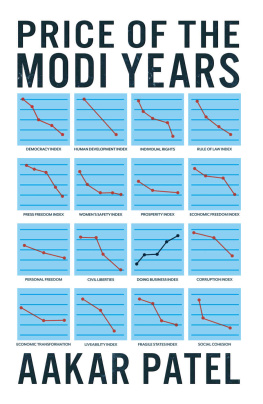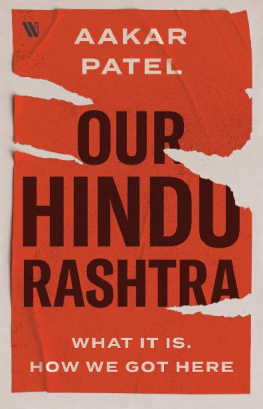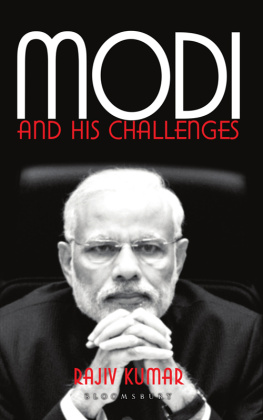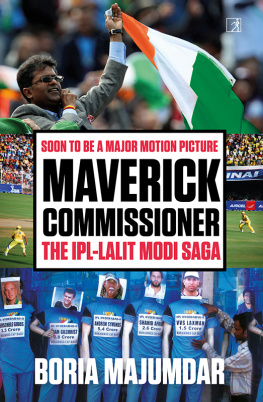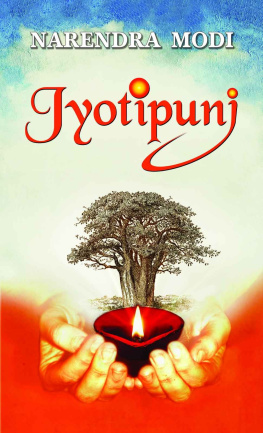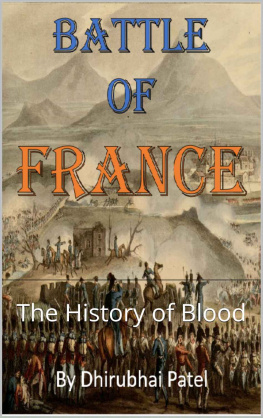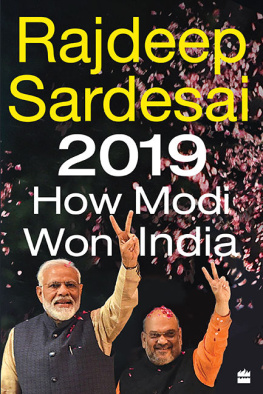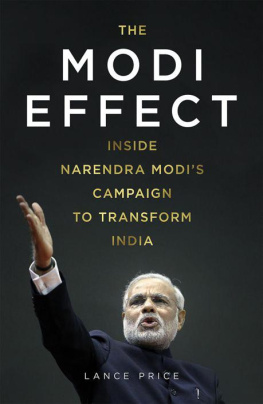Aakar Patel - Price of the Modi Years
Here you can read online Aakar Patel - Price of the Modi Years full text of the book (entire story) in english for free. Download pdf and epub, get meaning, cover and reviews about this ebook. year: 2021, genre: Politics. Description of the work, (preface) as well as reviews are available. Best literature library LitArk.com created for fans of good reading and offers a wide selection of genres:
Romance novel
Science fiction
Adventure
Detective
Science
History
Home and family
Prose
Art
Politics
Computer
Non-fiction
Religion
Business
Children
Humor
Choose a favorite category and find really read worthwhile books. Enjoy immersion in the world of imagination, feel the emotions of the characters or learn something new for yourself, make an fascinating discovery.
- Book:Price of the Modi Years
- Author:
- Genre:
- Year:2021
- Rating:4 / 5
- Favourites:Add to favourites
- Your mark:
- 80
- 1
- 2
- 3
- 4
- 5
Price of the Modi Years: summary, description and annotation
We offer to read an annotation, description, summary or preface (depends on what the author of the book "Price of the Modi Years" wrote himself). If you haven't found the necessary information about the book — write in the comments, we will try to find it.
Price of the Modi Years — read online for free the complete book (whole text) full work
Below is the text of the book, divided by pages. System saving the place of the last page read, allows you to conveniently read the book "Price of the Modi Years" online for free, without having to search again every time where you left off. Put a bookmark, and you can go to the page where you finished reading at any time.
Font size:
Interval:
Bookmark:
PRICE OF THE MODI YEARS
Aakar Patel is a syndicated columnist who has edited English and Gujarati newspapers. His translation of Saadat Hasan Mantos Urdu non-fiction, Why I Write, was published by Tranquebar in 2014. His study of majoritarianism in India, Our Hindu Rashtra: What It Is. How We Got Here, was published by Westland in 2020. He is Chair of Amnesty International India.


First published by Westland Non-Fiction, an imprint of Westland Publications Private Limited, in 2021
1st Floor, A Block, East Wing, Plot No. 40, SP Infocity, Dr MGR Salai, Perungudi, Kandanchavadi, Chennai 600096
Westland, the Westland logo, Westland Non-Fiction and the Westland Non-Fiction logo are the trademarks of Westland Publications Private Limited, or its affiliates.
Copyright Aakar Patel, 2021
ISBN: 9789391234225
The views and opinions expressed in this work are the authors own and the facts are as reported by him, and the publisher is in no way liable for the same.
All rights reserved
No part of this book may be reproduced, or stored in a retrieval system, or transmitted in any form or by any means, electronic, mechanical, photocopying, recording, or otherwise, without express written permission of the publisher.
CONTENTS
T his book seeks to explain the data and facts on Indias performance under Narendra Modi through character flaws in its transformational leader.
These defects are Modis intellectual indifference, his inability to change perspective and his impatience with detail and nuance. This should have been obvious much earlier: his bigotry admitted no shades either. But as prime minister and a figure of mass adoration the flaws ran alongside his power to bring about rapid and momentous change.
The results became apparent quickly enough. His predecessor as prime minister, Manmohan Singh, had once said that Modi would be a disaster as prime minister. This book shows how. It concedes Modis popularity; this is an accounting of the damage he has wrought.
Our memories are not long, news cycles are transient and incidents are forgotten or misclassified as being only episodic unless documented, unified and placed together as a record.
And therefore this booka history of these present times.
Id like to thank Karthik and Deepthi at Westland and Tushita at home.
Thanks also to Ajaz, Anusua, Alex, Ghazala, Hartosh, Kiran, Mahmood, Mihir, Naresh, Rahul, Reetika, Samar, Shailesh, Suhasini, Sushant, Somesh, Usman, Venu, and Vivek.
Aakar Patel
Bangalore
O n 23 May 2019, Narendra Modi returned to power winning a magnificent victory in the worlds most populous democracy. He did this by widening the base and bringing more voters into his Bharatiya Janata Party (BJP) than its leaders before him. The BJPs vote share under Modi in the 2019 election was 38 per cent nationally. This is twice what it was under L.K. Advani in the election of 2009, and considerably higher also than what the party had secured before that under Atal Bihari Vajpayee. The BJP (and its earlier form, the Jana Sangh) was not originally a particularly popular national party. Even at the regional level, it did not win a single state on its own from 1951 till 1990. It was Advanis mobilisation of Hindus around India against Muslims using the totem of the Babri Masjid that made the party nationally popular. The mass mobilisation around violence took the BJPs national vote share to double digits for the first time in 1989 (11.3 per cent), and it continued to climb before pausing at around 25 per cent in 1999.
Vajpayee had inherited a Jana Sangh that was a cadre-based party with a frame provided by the Rashtriya Swayamsevak Sangh (RSS), whose ranks staffed the organisations bureaucracy and leadership. He then announced the transition of the Jana Sangh to a mass-based party with a renaming in 1980, but the BJP under him was not really mass-based or popular because Vajpayee didnt know what issue to mobilise the masses on. Advani discovered that religious hatred was an efficient tool for mass mobilisation and aggressively pushed the Babri campaign, bringing in crores of new voters enthusiastic about the BJPs brutalising of Indias Muslims.
Modis contribution has been to align the party to its original RSS roots while retaining and increasing mass support and bringing crores more to the ideology of Hindutva. He has legitimised and normalised the RSS and made its values promoting an exclusionary nationalism acceptable to Indians. What was once communal is now legitimate and what was secular has been made inauthentic. It is a remarkable achievement and must be acknowledged.
Modi has done this through his person, not through the BJP, which has been almost incidental to Modis popularity. The RSS is today a sub-set of the Modi BJP, rather than the other way around, as it was before. The head of the RSS, Mohan Bhagwat, is actually junior to Modi in that sense.
The two go back a long way and have likely known each other since 1967 when both of them were boys of seventeen. Modi was familiar with Bhagwat through Bhagwats father Madhukarrao, who was Modis mentor in the RSS, and Modi stayed with the Bhagwat family during his essential training when he was around twenty.
Madhukarrao was one of the many Marathi Brahmins dispatched by the RSS from Nagpur in 1941 to infect Gujarat with Hindutva. He was a competent organiser and set up shakhas or neighbourhood branches in 115 cities and towns, including Surat, Baroda and Ahmedabad.
He learned, according to Modis biographical sketch of him, to speak a beautiful and fluent Gujarati and, in the Baroda shakha, which had a large number of Marathi speakers, forbade the speaking of Marathi.
Under Modi, the RSS cadre owes its loyalty first to Modi and then to Bhagwat. There is no way that the RSS can order Modi around, and it would amuse its storm troopers to think that it was possible even if the RSS desired it, which it of course doesnt.
Modi has no internal challenge in the party, either, of course. Those who built it, like Advani, he has brushed aside and made irrelevant. There is no leader in the BJP except at Modis sanction, and no other power centre. It is not easy to think of the last timeperhaps it was neverthat an Indian leader with a majority had such absolute authority and control over party, government and people. Modi is unfettered also by the political opposition, which he has in fact bent to his will.
On that triumphal night in May 2019, he said: Brothers and sisters, in our country no election has happened like this. You have seen that for thirty years especiallyalthough the drama has been going on for yearsit had become fashionable to wear a tag called secularism. And there used to be chants for the secular to unite. You would have seen from 201419, that entire section has stopped talking.
In this election, not even one political party has the guts to wear the mask of secularism to fool the country. They have been unmasked.
This is quite true. Modi has taken India to a place where political parties dare not speak of secularism and pluralism though it is the basic structure of our Constitution. The pushing of constitutional secularism has also disappeared from the mainstream media today, as had happened earlier in Gujarat after 2002. We can legitimately call it the Modi effect.
Modis victories and unchallenged position have given us an opportunity to observe a rare phenomenon in democratic politics: a leader of strong character traits that find expression in his manner of functioning and no restraint. Modi has been able to craft and mould the entire polity with his talents and present us with the finished product.
Next pageFont size:
Interval:
Bookmark:
Similar books «Price of the Modi Years»
Look at similar books to Price of the Modi Years. We have selected literature similar in name and meaning in the hope of providing readers with more options to find new, interesting, not yet read works.
Discussion, reviews of the book Price of the Modi Years and just readers' own opinions. Leave your comments, write what you think about the work, its meaning or the main characters. Specify what exactly you liked and what you didn't like, and why you think so.

